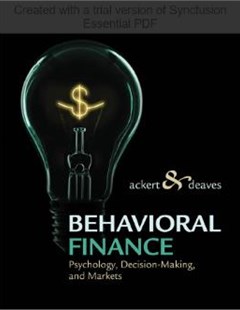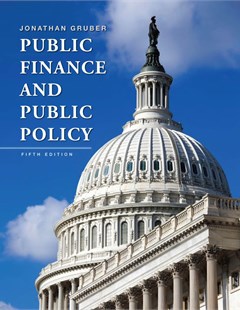Behavioral Finance: Psychology, Decision-Making, and Markets
The book clearly explains what behavioral finance indicates about observed market outcomes as well as how psychological biases potentially impact the behavior of managers. Readers see, first-hand, the implications of behavioral finance on retirement, pensions, education, debiasing, and client management.
2018
The book Behavioral Finance: Psychology, Decision-Making, and Markets. This comprehensive text--ideal for today's behavioral finance elective--links finance theory and practice to human behavior. The book begins by building upon the established, conventional principles of finance before moving into psychological principles of behavioral finance, including heuristics and biases, overconfidence, emotion and social forces. Readers learn how human behavior influences the decisions of individual investors and professional finance practitioners, managers, and markets. The book clearly explains what behavioral finance indicates about observed market outcomes as well as how psychological biases potentially impact the behavior of managers. Readers see, first-hand, the implications of behavioral finance on retirement, pensions, education, debiasing, and client management.
The contents of the book include 8 sections, 20 chapters:
- Section I: Conventional finance, prospect theory and market efficiency.
+ Chapter 1: Foundations of conventional finance: Expected utility.
+ Chapter 2: Foundations of conventional finance: Asset pricing theory and market efficiency.
+ Chapter 3: Prospect theory, framing and mental accounting.
+ Chapter 4: Limits to arbitrage, anomalies and investor sentiment.
- Section II: Behavioral science foundations.
+ Chapter 5: Heuristics and biases.
+ Chapter 6: Overconfidence.
+ Chapter 7: Emotion.
- Section III: Investor behavior.
+ Chapter 8: Investor behavior stemming from heuristics and biases.
+ Chapter 9: The impact of overconfidence on investor decision-making.
+ Chapter 10: Emotion-based investor behavior.
-Section IV: Social forces.
+ Chapter 11: Social forces: Selfishness or altruism?
+ Chapter 12: Social forces and behavior.
- Section VI: Market outcomes.
+ Chapter 13: Behavioral explanations for anomalies.
+ Chapter 14: Aggregate stock market puzzles.
- Section V: Corporate finance.
+ Chapter 15: Irrational markets.
+ Chapter 16: Irrational managers.
- Section VII: Retirement, pensions, education, debiasing and client management.
+ Chapter 17: Understanding retirement saving and investment behavior and improving DC pensions.
+ Chapter 18: Debiasing, education, and client management.
- Section VIII: Money management.
+ Chapter 19: Money management and behavioral investing.
+ Chapter 20: Neurofinance and trading.
Lucy F. Ackert, Richard Deaves. Behavioral Finance: Psychology, Decision-Making, and Markets, South-Western, 2018.
 |  | |
Behavioral Finance: Psychology, Decision-Making, and Markets | Public Finance and Public Policy | Money, Banking and Financial Markets |
Chủ Nhật, 15:56 05/03/2023
Copyright © 2018 Hanoi University of Industry.